How to Make Bone Broth
Mar 19, 2015, Updated Dec 09, 2020
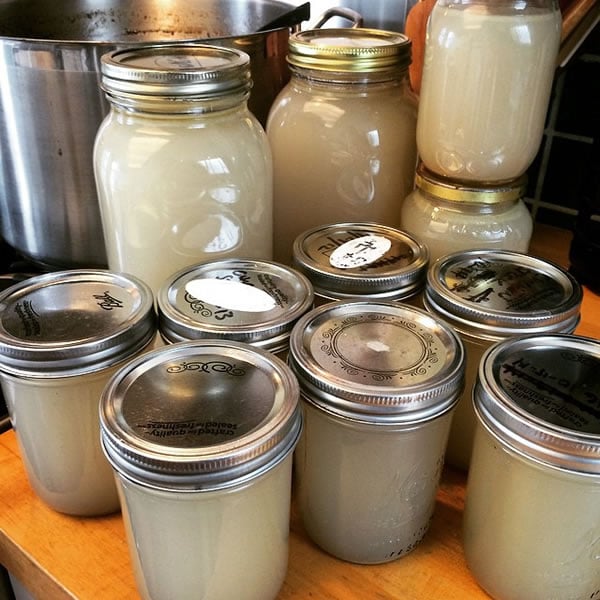
It’s been a very full couple of weeks since I last wrote about Molly. I’m pleased to report that she’s doing well. We have had good days and bad days, but thankfully this week has been more good than bad.
After my last post, a few helpful readers suggested removing the rice from her diet. I had been thinking the chicken was possibly an issue (it’s the most common food sensitivity for dogs), but since more than one person pointed out that grains (even “bland” rice) could be hard for her to digest, I took heed and swapped it out for canned Organic pumpkin instead. That seemed to be a good move (Thanks, team!).
We also decided to get a second opinion. Another reader, Sharon, suggested we reach out to Dr. Mona Rosenberg, head of the Veterinary Cancer Group. We had a great consultation — she’s clearly brilliant — but unfortunately, she pretty much agreed with Dr. Chretin’s diagnosis and potential treatment options. The bottom line, from a “Western Medicine” viewpoint is that Molly has a rare cancer and it’s not well-studied, so we just don’t know how it’s likely to react to various treatments. Either of the “best” options (chemotherapy or an anti-angiogenesis drug) might have a decent shot at slowing the cancer down, but if we had to put a number on it, it’s something like 50/50 odds of either one doing much good at all. And of course both options come with possible side effects and a high price tag.
While pondering the options, I also asked Dr. Rosenberg if she could recommend a good holistic veterinarian. Without a moment’s hesitation, she sent me to Dr. Richard Palmquist, at the Centinela Animal Hospital. He’s a past-President of the American Holistic Veterinary Medical Association (and is still on the board of directors). She said he’s “The” guy to see, and even though it’ll probably take a couple of weeks to get an appointment, he’s worth the wait.
The next day I called to make an appointment. The planets aligned, and he had an opening for the next morning!
Dr. Palmquist talks quickly, with an intense, radiant energy and enthusiasm. He started our consultation by playing with Molly for a couple of minutes, and he immediately sensed her intelligence. She liked him, too. He clearly has a way with animals.
I particularly like that he uses both Western and Eastern medicine. After reviewing her records, he posited that the cancer is a result of the digestion issues she’s been having for so long. It makes perfect sense — the organs where the cancer started (pancreas) and metastasized (liver) both primarily help with digestion. So the thinking is that we need to heal her digestive system before we do anything else.
He prescribed two herbal pills (in addition to her current meds, not instead of them): “Six Gentlemen Tea Pills” to help her digestion, and Xue Fu Zhu Yu Tang, to help fight the cancer. My marching orders were to start her on the Six Gentlemen now, and six days later on the other pills, and come back in three weeks. As soon as I got home I got started.
The next day, she had another bout of both diarrhea and vomiting. It may have been a coincidence, or it may have been that she just wasn’t ready for the Six Gentlemen yet. In any event, we needed to rethink her food. Dr. Palmquist also wanted to steer her away from chicken (it’s a “hot” food in Eastern medicine — not good for the digestion), and we both wanted to get her away from the Gerber Ham Baby Food. He suggested turkey or pork, and I figured that since she liked the pink-slime-ham so much, we should try pork first.
His other suggestion was to give her bone broth. Many of my paleo and grain-free and real food friends have been singing bone broth’s nutritional praises for a long time now*, and it seemed so simple it was brilliant, like the answer was staring us in the face all along!
I’m a big fan of our electric pressure cooker, so I asked Dr. Palmquist if I could use it instead of the 6-hour-plus simmer time he recommended. He told me “There some magic stuff in those bones, we don’t know exactly what it is, but slow cooking seems important.”
So, slow-cooking it shall be.
I have made chicken stock with leftover chicken carcasses before, but I wasn’t sure if “bone broth” was something different, so I asked Dr. Palmquist how to make bone broth. Turns out, as long as you’ve got lots of bones in the pot, and you simmer it for hours and hours (longer for bigger bones), you’re making bone broth!
Molly devoured the chicken broth — I’ve never seen her drink that fast. Clearly, another good sign that we’re on the right track.
However, she’s been really itchy since we started the pork & bone broth combination. It could be the pork, but more likely it’s the “concentrated” chicken broth. So we’re switching to beef broth. Matty picked up about four pounds of “Step 4” (Pastured and Grass-Fed) Beef Bones from our Whole Foods butcher, and yesterday I started a huge batch of beef broth.**
Molly seems to like it as well, so here’s hoping this will soothe her itching, ease and improve her digestion, and get her back on the path of wellness for as long as possible.
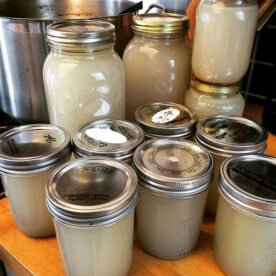
How to Make Bone Broth
For Molly, I didn't add any vegetables or seasonings, other than bay leaves and vinegar, since we want to keep it as simple as possible for her right now. But for you, I'd suggest adding vegetables, herbs, and spices - a few options are noted in the recipe below.
This recipe can be made on the stove or in a slow-cooker -- but don't try to speed the process with a pressure cooker. The vinegar helps leach out additional nutrients from the bones, and the bay leaves, according to Dr. Palmquist, are "antibacterial and anti-inflammatory, and drain the lymphatic system."
Ingredients
The Basics
- 2 to 3 pounds bones
- 2 bay leaves
- 1/4 cup apple cider vinegar
- 4 to 6 quarts filtered water
Veggies
- 2 carrots
- 2 celery stalks
- spring of rosemary and/or thyme
For Humans Only
- 1 onion, chopped in large chunks
- 1/2 teaspoon whole peppercorns
- salt, to taste (add after cooking)
Instructions
- In the largest pot you own (or in your slow-cooker), add the bones, bay leaves, and vinegar. Fill with water. If making this for people and not for pets, add the onion and peppercorns.
- Bring to a boil, and then skim off any foam that comes to the surface. Turn heat to the lowest possible setting on your stove or slow-cooker, and cover.
- Let simmer for at least 6 hours and up to 72 hours. The larger the bones, the longer you'll want to go. If you're losing a lot of water to evaporation, it's okay to top off with a little extra boiling water.
- If making this for people, add salt to taste, being careful not to burn your tongue!
- Allow to cool, and then skim the fat off the top and discard. Strain and pour into jars to store. If storing in the fridge, use within a few days, or store in the freezer for several months.
Notes
Nutrition
* When people start extolling one particular food’s virtues for myriad symptoms, that should definitely be a red flag. Although I think it’s likely highly nutritious, keep in mind that bone broth is not a complete cure-all.
** For those of you curious about the nitty-gritty details of Molly’s food: Right now we’re giving her very small meals, four or five times a day, consisting of about 1/2 cup ground pork (cooked in a skillet, fat drained, and then shredded in a food processor), 2 tablespoons Organic pumpkin, and about 1/2 cup of broth. I’m also giving her metoclopramide three times a day to help her motility (crushing the pills and mixing with some broth), and ondansetron in the mornings to help with any potential nausea or vomiting. We may reintroduce omeprazole to help with acid reflux, but I’m holding off for now. Once she’s stable for a few more days — and pooping again! — we may try the Six Gentlemen again, but a little slower this time.
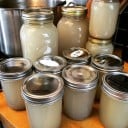

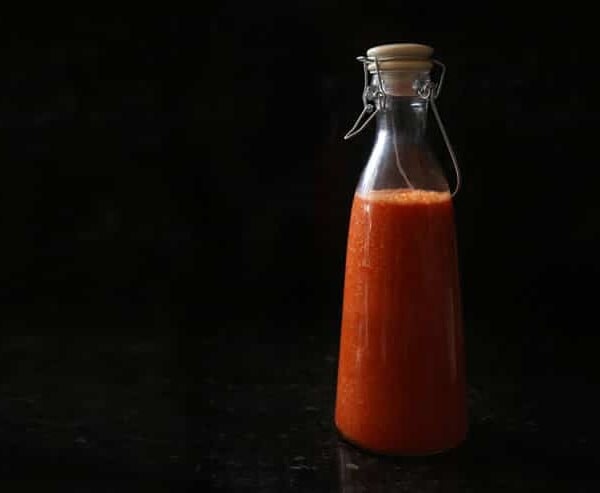

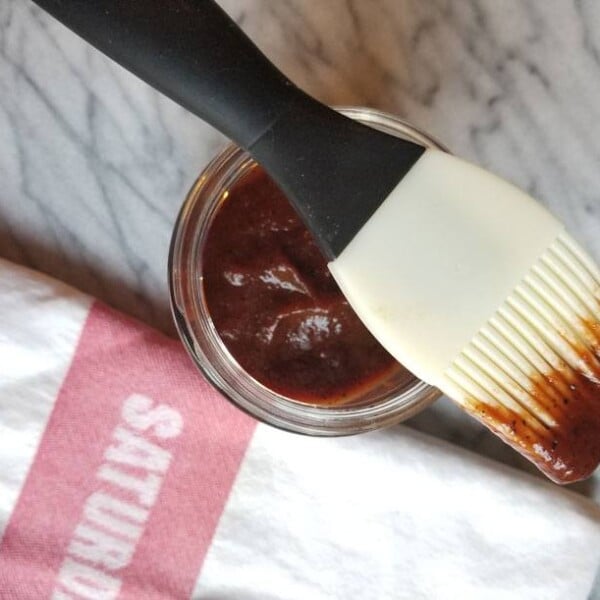
















Onion should not be given to cats or dogs! Why did you include this in the ingredients.
You’re right — and I noted that in the ingredient list (“omit for dogs”). I included it since this is primarily a blog for humans, and I wanted this recipe to be tasty for people, too.
Well you should have included cats in that omission. Lots of dumb people around unfortunately
Thanks for the feedback, Denise. I just edited the recipe to make it a lot clearer (I hope!). 🙂
Cats should not have onion, garlic or bay leaves per my vet
I used to make bone broth for my cats and dogs, but it was very time consuming. Now I buy a bone broth tea from bustersbrew.net and they all love it.
In humans the Ondansetron has the side affect of severe headaches. If Molly is a bit lethargic for a few hours after she gets this it might not be nausea but pain keeping her down. Just an FYI.
Interesting. We haven’t noticed any side effects of the Ondansetron, and she’s not particularly lethargic after breakfast. I actually stopped giving it to her for a couple of weeks recently (I was trying to isolate variables, looking for potential side effects…), and found she actually did better once she was back on it. I do appreciate the insight, though! 🙂
Would it be safe to use a mix of cooked and uncooked bones? I
Sure! I use raw bones for Molly’s stock, but a lot of people like to roast the bones in the oven first — which some say will give you a better flavor in the end result.
That’s good dog food! I’d even eat it. GREG
Hi Andrew, I am so glad you found the broth! I have not idea why I didn’t think of suggesting it. I feed my dogs broth made of duck carcases. I had a very allergic dog and read somewhere that duck is a good choice. I add lemon juice and cook it in the slow cooker overnight, sometimes add some seaweed and some turmeric and other therapeutic spices and herbs and sometimes mix it with stinging nettle. I’m always asked what I feed my dogs…I know how special that broth is! I have it and the family has it regularly – It is real traditional magic food we have forgotten about.
thanks so much for these posts and such care and love for molly, she could not have a better home! I wish Molly well
It’s so lovely to hear what an amazing job you are doing caring for your dog. I hope Molly does amazing on her treatments and you get more time with her than expected:) she is lucky your family adopted her and I can tell how much joy she brings.